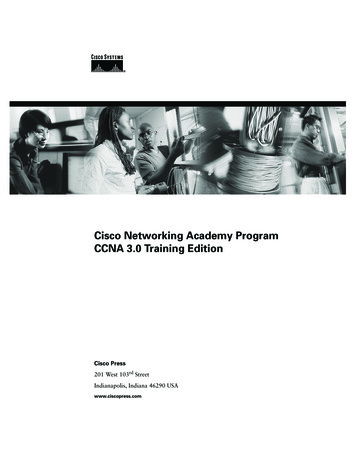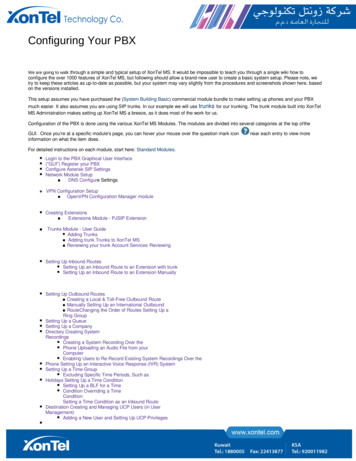
Transcription
Module6Enjoy the ride
Keys to Your Financial FutureModule 6:TransportationEnjoy the rideKeys to Your Financial Future is designed to help youplan how to get, manage, and use money now and in thefuture so you can have the life you envision for yourself.If you are reading this module of Keys to Your FinancialFuture you have completed the core modules: AssetBuilding, Good Credit, and Money Management. Thismodule of Keys to Your Financial Future covers gettingtransportation and managing the costs of transportation.The information in this module will build on conceptsyou learned about in the core modules.When you finish this module of Keysto Your Financial Future, you will beable to do the following: List the qualities of safe, reliable andaffordable transportation. Identify and budget for mode oftransportation that is safe, reliableand affordable.In the first module, you learned about asset buildingand the role of productive assets. As a youngperson in or transitioning from foster care, access totransportation is one of your key productive assets. Determine amount of income dedicatedto transportation that is affordable. Explain transportation as an asset.Having transportation allows you to: Describe the risks and rewards ofowning a car. Get to school. Explain how to search for cars to buy. Get to a job. Describe the steps to take to ensure acar is not a lemon or a bad deal. S tay connected with your socialnetworks and your family. Explain the basics of car financing. Engage in volunteer or other activities. List the barriers to getting a car andstrategies for managing these barriers. Describe the steps needed to get adriver’s license.This module will focus on getting and paying for safe,reliable and affordable transportation. If you areusing your matched savings for transportation-relatedinvestments, this module will be especially importantfor you. But, whether you rely on public transportation,own a car or hope to own a car, transportation will bea key to your financial future. E xplain basic automobileinsurance terms.1
2MODULE 6: TransportationSafe, Reliable, and Affordable TransportationGetting where you need to go is important. Whether it isto school, employment, the Opportunity Passport FinancialEducation Training, or visiting your friends and family, havingsafe, reliable, and affordable transportation is a key tobeing independent.What does safe transportation mean?What does reliable transportation mean?What does affordable transportation mean?Everyone has the right towalk from one end of the city tothe other in secure and beautifulspaces. Everybody has the right togo by public transport.— richard rogers
Keys to Your Financial FutureBalancing safety, reliability and affordability when it comes totransportation can be difficult. Having a new car with all of theavailable safety features may provide you with safe transportation.But the costs of a new car may make it an unaffordable option.You may get an old car for a few hundred dollars. This may seemaffordable. But, it may not be safe, and it may end up costingyou because it has low gas mileage and may require a lot ofrepairs. You may live in a community that has bus service. But,the schedule may not be regular or available at times you needit—it may not be reliable for you.This module will help you figure out what is safe, reliable andaffordable for you now or when you transition from foster care.Transportation OptionsUnless you live within walking distance of where you go toschool, where you work, where you can visit your friends andfamily, or where you may volunteer, you will need to have someform of transportation.What transportation options can you think of?Safe, Reliable and AffordableKEYConceptThere are manydifferent factorsthat might playinto your choicefor transportation.Focus on three:DD Safety—will you be safe andkeep others safe using thistransportation option?DD Reliability—is the transportationavailable when you need it? Is itsomething you can count on?DD Affordability—is it somethingyou can pay for without stressingyou or your budget? Are yourtransportation costs below 20%of your net income? (Remembernet income is after taxes anddeductions. It is what you takehome, not what you make.)Nothing compares to thesimple pleasure of a bike ride.— john f. kennedyCircle the options that are possible for you.The process of determining which transportation options are possible for you starts with identifying your needs.Why do you need transportation? This can help you determine what types of transportation options are trulyoptions for you.3
MODULE 6: Transportation4Keys to Your Financial Future Step 6.1:Transportation Needs AssessmentComplete the following table to help you determine your transportation needs. Identify what transportation optionsyou actually have in getting from where you live to where you need to go and then back again to where you live. Usethe “other” spaces to identify other places you may need to go in any given week.WalkSchoolExtracurricularactivities (sports,band, clubs, etc.)OpportunityPassport Trainings andMeetingsYouth BoardMeetingsOtheropportunitiesfor socializing—visiting or goingout with friendsand familyJobBank orcredit unionGrocery store orother errandsnecessary tosupport yourselfOtherOtherOtherTotal inEach ColumnBikeSomeoneelse canreliablydrive or ex.)Motorcycleor scooterPersonalcarneeded
Keys to Your Financial FutureOnce you have filled in the table, total the responses ineach column. The column with the highest score is likely thetransportation option you can rely on or need to invest in for thetime being. If you are still in foster care, you may want to repeatthis exercise thinking about what your transportation needs willbe once you are ready to transition to independence.Walking isn’t a lost art—one must, by some means, get tothe garage.— evan esarHow Much Should You Spend on Transportation?Transportation takes 10% to 20% of the budget of most people in the United States.In 2009, transportation represented 15.6% of the household budget.1Once you are living independently, you can use 20% of your budget as a maximum threshold to ensure yourtransportation costs are not eating up more of your budget than they should be. This means that if you have 1,800 of monthly net income, your total transportation costs should be below 360 per month. 1,800 .20 360Keys to Your Financial Future Step 6.2:Maximum Transportation ExpendituresIf you are living independently, complete the following worksheet to identify the maximum amount you should keepall of your transportation costs.Monthly net income .20 What do you think are the risks of spending more than 20% of your net incomeon transportation?1From the U.S. Bureau of Labor Stastics at www.bls-gov/cex/csxann09.pdf. Accessed May 2012.5
6MODULE 6: TransportationKeys to Your Financial Future Step 6.3:Transportation BudgetIf you are using or going to use anything except a personal car, use the form below to make yourtransportation budget.TransportationcategoryOne-time oroccasional expensesOngoing orregular expensesOne-timepurchase costTripsper weekMaintenancecostsTotal costCostper tripBicyclePaying friend or otherwho drives me for gasPublic transportationTaxiCar sharingOtherOtherTotal Ongoing CostsTotal One-Time orMaintenance Costs 4Monthly Estimate
Keys to Your Financial FutureTransportation and Asset BuildingIs transportation an asset?What kind of asset is transportation?Safe, reliable and affordable transportation is a productiveasset. A productive asset is one that helps you get and keep otherassets. In fact, some people would say that after education andtraining, transportation is your next most important productiveasset because it connects you to jobs, volunteer opportunities,your social network, and more.In most U.S. communities, people rely on cars to meet theirtransportation needs. This is because they cannot live, work,go to school, and accomplish everything they need to do bywalking. In most communities, public transportation is not anoption either. This is because it may not exist or the schedulesmay be inadequate.If you are lucky enough to live in a community that has robustpublic transportation—New York City, Boston, Chicago,Washington DC, or San Francisco—you may avoid the cost ofowning and operating a car. You will likely, however, pay morefor housing.In module 1, you learned about your asset building portfolio.Your asset-building portfolio is your collection of assets includingthe asset building you are doing now. The key was keeping yourasset building portfolio in balance—investing time, money, andother resources in all asset-building areas.Transportation andAsset BuildingAfter education andtraining, somepeople would saytransportationisyour next mostConceptimportant asset.Why? Safe, reliable andaffordable transportation connectsyou to everything. Without it, youmay not be able to get to school,get to employment opportunities,volunteer, or build your social capital.KEYInvesting in transportation isasset building—it’s building aproductive asset.7
MODULE 6: Transportation8How does investing in transportation contributeto your asset building portfolio?AutomobileDoes it add balance? YES NOIf no, why doesn’t it?Transportation& AutomobileCars and DepreciationWhen an asset losesvalue, it depreciates.Cars as a ruledepreciate quicklyrelative to otherConceptassets. This means thatthe car will be sold for lessthan when it was new.KEYThe greatest percentage ofdepreciation happens within thefirst two years an automobile isowned and driven. This is the reasonmany people look for used cars thatare at least two years old. But everyyear a car is driven and owned, itis likely to lose a little more value.Today, 95% of Americans own cars. 85% of Americans use cars toget to their jobs. It wasn’t always like this. People used to live incities and walk or take public transportation to their jobs. Then thesuburbs were created—cheap houses on cheap land—beyond thereach of most public transportation.2 So people traded city life forsuburban life, but in turn needed cars to connect them to jobs.Today more and more people are advocating for increased accessto public transportation. Some communities are also investingin walking and biking trails to provide people with safe ways toschool and work. Most people are still in situations that requirecars to get them from affordable housing to jobs and otheropportunities.What kind of asset is an automobile?Cars may be worth little in termsof their financial value because ofdepreciation. But they may remainproductive if they still work reliably.U.S. Department of State’s Bureau of International Information Program. You Asked: Does Everyone in America Own a Car? By Robin Chase.www.america.gov. Accessed May 2012.2
Keys to Your Financial FutureAn automobile that you own is a physical (tangibleasset). It is something you own that has value. Likeother assets, sometimes you have to borrow moneyto get the asset.Take most people, they’re crazy aboutcars. They worry if they get a little scratchon them, and they’re always talking abouthow many miles they get to a gallon, and ifthey get a brand-new car already they startthinking about trading it in for one that’seven newer. I don’t even like old cars. I meanthey don’t even interest me. I’d rather have ahorse. A horse is at least human.KEY ACTIVITYDepreciation and EquityWith the group or a partner, read the case studyand calculate the equity of Tayvonne’s car.Tayvonne wants to buy a car. He has found a safecar that is certified by a used car dealer selling for 7,500 including sales tax. It gets good mileage(30 city/36 highway), so he feels it will be affordable.He has 500 for a down payment, so he will haveto borrow 7,000.— J.D. Salinger, catcher in the ryeOn the day he buys the car, he will have 500 in equity in the vehicle.Automobile value: 7,500minusAssetAutomobile loan: 7,000equalsLiability 500EquityAs Tayvonne pays down his loan, his equity should increase. But because cars depreciate (lose value) the valueof the asset will also decline.He does not have much of a credit history, so the best rate he can get at the credit union for the loan is 9.25%.To keep his monthly payments manageable, he is opting for the 3-year loan term rather than 2-years. His monthlypayments are 223.41.After one year of on time payments, how much equity will he have?Automobile value: 6,800AssetminusAutomobile loan: 4,878.07Liabilityequals?EquityDuring this first year, he will have paid 559.04 in interest.Sometimes automobiles will be driven to the point where they have little financial value. This is because ofdepreciation. Even though a vehicle is no longer worth much, it may still be a productive asset. This means it can stillhelp you get and keep other assets. A car that is not worth much can still get you to and from school, a job, volunteercommitments, and social opportunities.Therefore a car is both a physical asset and productive asset.9
10MODULE 6: TransportationKEY ACTIVITYA Car as a Productive AssetRead the case study below. Describe the ways in which a car is aproductive asset for Mei by identifying the assets it helps her getand keep.Mei was 18 years old and still in foster care. She had recentlyenrolled in Opportunity Passport . After meeting with staff atthe Opportunity Passport site, she decided to use her matchedsavings for a car. She had been accepted into a veterinariantechnician (vet tech) program the following fall and had most ofthese expenses covered using the Chafee ETV program as well asother federal grants and loans.While Mei was saving for her car, the Opportunity Passport staff helped her find an appropriate driver’s education course.She completed this. The staff also coached her on getting herdriver’s license.A Car as a Productive AssetCars do not generallyincrease in value.The only exceptionto this rule iscollector cars or carsConceptthat are rare. Mostpeople buy a car knowingit will decline in value.KEYSo why do they do it? Because a car isa productive asset for them.Even if a car’s book value (the value itcould be sold for) is near zero, it canstill get you to your job, your schooland help you connect with your familyand social networks.Upon reaching her savings goal, she used the information fromthe Opportunity Passport Financial Education Training tocomparison shop for a used car. First she determined what shecould afford. Then she researched vehicles that would be safe,reliable and affordable in this price range using Kelley Blue Book and Consumer Reports. Then she reviewed theclassified ads, visited a car dealer and visited a used car superstore. In the end, she bought a certified used car fromthe used car superstore.With her own transportation, Mei was able to get a better job paying 9.50 an hour (previously she had been makingminimum wage with hours only on the weekend because she could not reliably get to a job during the week). Shewas also able to volunteer at a local animal shelter. Through this volunteer experience, she met and worked with twoveterinarians who were also volunteering their time at the animal shelter. One of those veterinarians invited her towork for her while she was in vet tech school. Mei had never dreamed this kind of opportunity would be a possibilitybefore completing her education, and she immediately accepted this position.Mei was also able to make all of the youth board meetings and agreed to mentor another young person in foster carewho was two years younger.Finally, having her own transportation allowed Mei to visit her brother and sisters who were in foster careplacements 25 miles from where she lived. Being able to see her siblings one or two times per month brought a lotof joy to Mei’s life.What assets does Mei get because of the car?
Keys to Your Financial FutureWhat assets does Mei get to hold onto or retain because of the car?Risks and Rewards of Owning a CarOwning a car can bring many rewards as described in theprevious case study. But with rewards come risks. A risk isany chance of loss. Owning a car not only provide rewards,but exposes you to new risks.Don’t drive as if you ownedthe road. Drive as if you ownedthe car.— anonymousKEY ACTIVITYRewards and Risks of Owning a CarWith a partner or your small group, brainstorm a list of the rewards to owning a car.Then identify the risks that come with getting those rewards.Rewards of Owning a CarRisks of Owning a CarThe rest of this module will examine ways to lessen some of those risks—from learning about financing vehicles to learning how to research vehicles.If you think you will always be able to rely on public transportation or someother kind of transportation that is not your own car. The rest of this moduleis specifically about getting and insuring a safe, reliable and affordable car.11
12MODULE 6: TransportationBuying a CarWhen you buy a car, you can do one of the following:DD Pay for it in full.DD Finance it over time.If you finance it over time, you will pay more for the total price of the car because of the interestand fees on the loan.KEY ACTIVITYPaying in Full vs. Financing a CarWith a partner or your group, read the following case study. Then answer the questions that follow.Aaliyah and Alex are shopping for cars together following one of the Opportunity Passport Financial Educationclasses. Aaliyah is planning to use her matched savings to buy a car. She wants to pay cash. Alex is using hismatched savings for education. He wants to finance a car—get a loan for it. They find a used car in good conditionfor 6,000 including sales tax.Aaliyah will pay 6,000 for the car.Alex can get a loan for the 6,000. He will pay 7.99% for the loan for 2 years. His amortization schedule is below.Using the amortization schedule on page 13, answer the questions that follow.What is Alex’s monthly payment?How much interest will Alex pay?How much more will Alex pay for his car than Aaliyah?
13Keys to Your Financial FutureLoan amount 6,000.00Annual interest rate7.90%Loan period in years2Start date of loanNo.1/1/2014PaymentDateBeginningBalanceMonthly payment 271.34Number of payments24Total interest 512.07Total cost of loanPaymentPrincipal 6,512.07InterestEndingBalance12/1/2014 6,000.00 271.34 231.39 39.95 5,768.6123/1/2014 5,768.61 271.34 232.93 38.41 5,535.6934/1/2014 5,535.69 271.34 234.48 36.86 5,301.2145/1/2014 5,301.21 271.34 236.04 35.30 5,065.1756/1/2014 5,065.17 271.34 237.61 33.73 4,827.5667/1/2014 4,827.56 271.34 239.19 32.14 4,588.3778/1/2014 4,588.37 271.34 240.79 30.55 4,347.5889/1/2014 4,347.58 271.34 242.39 28.95 4,105.19910/1/2014 4,105.19 271.34 244.00 27.33 3,861.191011/1/2014 3,861.19 271.34 245.63 25.71 3,615.561112/1/2014 3,615.56 271.34 247.26 24.07 3,368.30121/1/2015 3,368.30 271.34 248.91 22.43 3,119.39132/1/2015 3,119.39 271.34 250.57 20.77 2,868.82143/1/2015 2,868.82 271.34 252.23 19.10 2,616.59154/1/2015 2,616.59 271.34 253.91 17.42 2,362.67165/1/2015 2,362.67 271.34 255.60 15.73 2,107.07176/1/2015 2,107.07 271.34 257.31 14.03 1,849.76187/1/2015 1,849.76 271.34 259.02 12.32 1,590.74198/1/2015 1,590.74 271.34 260.74 10.59 1,330.00209/1/2015 1,330.00 271.34 262.48 8.86 1,067.522110/1/2015 1,067.52 271.34 264.23 7.11 803.292211/1/2015 803.29 271.34 265.99 5.35 537.302312/1/2015 537.30 271.34 267.76 3.58 269.54241/1/2016 269.54 271.34 269.54 1.79 (0.00)
14MODULE 6: TransportationWhat are the rewards for the way Aaliyah is paying for her car? The risks?RewardsRisksWhat are the rewards for the way Alex is paying for his car? The risks?RewardsRisksWould you rather be Aaliyah or Alex? Why?Although, Alex will pay more for the car, he does not have to come up with the full 6,000 at one time. He willpay a little of that amount plus interest every month for 24 months. Aaliyah on the other hand is trading off theuse of 6,000 all at once, but she will not have monthly payments to worry about.You will also have to choose between buying a new car and buying a used car. Most people find used cars moreaffordable upfront. Used cars cost less at the outset. But repair and maintenance costs may be higher becausethe car was owned by someone else (or possibly many people) before you.When it comes to financing a new car versus a used car, however, you will generally have a higher APR(annual percentage rate) and shorter terms (fewer months) on a used car loan than on a new car loan.
Keys to Your Financial FutureCar Financing BasicsWhy is New CarFinancing Different fromUsed Car Financing?There are many places that offer loans for cars:DD Banks and credit unions.DD Car dealers.DD Other loan providers.As with all loans, the better your credit report and credit scores,the less you will pay for the loan. In fact credit scores mattera lot. In September 2011, credit score ranges and loan rates fornew automobiles as well as down payment requirementswere as follows:4People with credit scores of 720 or greater (Tier 1 customers)BanksCredit Unions36 months3.63%3.54%48 months3.65%3.65%60 months3.73%3.76%0%0%Typical down paymentWhen it comes tofinancing a new car,your APR will belower and longerterms will be availableConceptto you when comparedwith used cars. Why?KEYIn auto loans, the loans are securedwith the vehicle being purchased.New cars are worth more, generallythey have fewer problems and fromthe perspective of the lender, easierto sell should you not pay on the loanand repossession becomes necessary.So, you get a break on the rate andterms for a new car.People with credit scores between 700 – 719 (Tier 2 customers)BanksCredit Unions36 months4.42%4.01%48 months4.44%4.12%60 months4.51%4.22%0%0%Typical down paymentWhen buying a used car,punch the buttons on the radio.If all the stations are rock androll, there’s a good chance thetransmission is shot.People with credit scores between 670 – 699 (Tier 3 customers)BanksCredit Unions36 months5.96%4.92%48 months5.97%5.03%60 months6.02%5.13%10%0%Typical down payment3www.quotegarden.com/driving.html. Last modified 2012 May 13 Sun 19:43 PDTCar Financing in a Recovering Economy Effortless for Prime Borrowers, Getting Easier for SubprimesPublished: 01/13/2011 Updated: 09/08/2011—by Ronald Montoya, Consumer Advice Editor www.edmunds.com.4 — Larry Lujack 315
16MODULE 6: TransportationPeople with credit scores between 630 – 669 (Tier 4 customers)BanksCredit Unions36 months7.95%6.72%48 months7.97%6.83%60 months8.04%6.95%15%0%Typical down paymentPeople with credit scores below these ranges are consideredsubprime or deep subprime. Subprime means the loans willcost a lot. Someone is considered to be a deep subprimecustomer if his or her credit scores are below 550 indicatingcredit problems. But, people with poor credit can get auto loans—they just pay more.According to Bankrate.com, in March of 2012, subprimeborrowers (those with credit scores between 550 and 630) werepaying on average 9.55% for new car loans and 14.17% on usedcar loans. Deep subprime borrowers (those borrowers with creditscores below 550) were paying on average 12.51% for new carloans and 17.38% for used car loans.Do a few percentage points of difference in auto loan rates make adifference? Review the following example and see what you think.Key Loan TermsPrincipal is the amountof money you borrow.KEYInterest is the “price”you pay to theConceptlender or creditor forborrowing the money.The price is quoted as an APR, whichstands for annual percentage rate.It includes both the interest rate andany fees that everyone getting thisloan would have to pay. APR does notinclude late fees, over the limit feesor other fees applied for not followingthe terms of the loan.Terms of the loan are the thingsyou agree to follow when taking outa loan. These include interest rate,kind of interest rate, fees, length ofthe loan, where payments are dueand more.KEY ACTIVITYDoes Interest Rate Really Matter?Use the information from the past few pages to answer the questions that follow.Olivia, Leonard, and Sam wereapplying for new car loans.The bank pulled one of Olivia’s creditscores. It was 650. What rate would shepay for a 36 month (3-year loan) at abank using the above information?Leonard’s credit score was 718. What ratewould he pay for a 36 month (3-year loan)at a bank using the above information?Sam’s credit score was 507. What ratewould he pay for a 36 month (3-year loan)at a bank using the above information?
17Keys to Your Financial FutureOlivia and Sam will pay more each month and more interest over the life of the loan than Leonard will.How much more? Compare the information %Term36 months36 months36 monthsAmount Borrowed (Principal) 15,000 15,000 15,000Monthly Payment 445.67 469.70 501.88 1,044.04 1,909.18 3,067.55Credit ScoreInterest Paid Over the Life of the LoanHow much more does Olivia paythan Leonard?How much more does Sam paythan Leonard?The length of the loan can also make a big difference in both the monthly payment and the amount of interestpaid over the life of the loan.If you increase the terms of the loan, willyour monthly payment go up or go down? UP DOWNIf you increase the terms of the loan, willthe total amount of interest you pay overthe life of the loan go up or go down? UP DOWNLeonard, Olivia, and Sam wanted to find out how things would change if they stretched out the terms of their loanfrom 3 years (36 months) to 5 years (60 51%Term60 months60 months60 monthsAmount Borrowed (Principal) 15,000 15,000 15,000Monthly Payment 279.10 303.79 337.55 1,746.00 3,227.23 5,252.72Credit ScoreInterest Paid Over the Life of the Loan
18MODULE 6: TransportationFrom these examples, you can see that the following are true:DD Lower interest rates mean lower monthly payment.DD Lower interest rates mean less interest paid over thelife of the loan.DD Longer terms mean lower monthly payments.DD Longer terms mean higher (and sometimes much higher)levels of interest paid over the life of the loan.Stringing a car loan out isnot healthy. Four years on an autoloan is normal. Seven years is not.Your loan shouldn’t last longerthan the car.Finally, it is obvious that if Leonard, Olivia, and Sam borrowedless money altogether—purchased a used car for half theamount—their monthly payments and total interest paid onthe loan would decrease.— greg mcbrideKey to determining which loan to take is three considerations:DD What can you afford?DD What can you maintain from a cash flow perspective—What payment can you sustain month after month evenif your income changes?DD What loan payment in combination with all otherexpenses of owning and operating a vehicle keepsyou below 20% of your net income?If you are under 18 years old, you will likelyneed a co-signor on the loan that is overage 18. Remember anyone that actsas a co-signor on your behalf islegally responsible for the loan.If you don’t pay, the creditor(bank, credit union, or car dealer)will go after your co-signor forpayment. If you don’t pay asagreed, your credit scores willdrop. And your co-signor’s creditscores will drop, too.Bad Credit, No ProblemKEYConceptHave you seen cardealers advertiseusing this phrase?They may also statethat they don’t turnanyone down!Dealers promising “financing foranyone” are likely to do the following:DD Require a very largedown payment.DD Charge a very high interest rate.DD Offer very short terms onyour loan.In general, these businesses shouldbe avoided. Often people end upowing a lot more than the car is worthbecause of the financing terms.If you cannot qualify for a car loan,review module 2 on credit and workwith Opportunity Passport site staffto bring up your credit scores.
Keys to Your Financial FutureWhen You Don’t Pay Your LoanWhen you don’t pay your autoloan as agreed, your vehiclemay be repossessed (the termRepo is commonly used insteadof repossession.). This is allowedConceptbecause you will have pledged thevehicle you are buying as collateral forthe auto loan—whether it is a new or used car.In fact, the lender has a lien on your automobileand may be listed as a lien holder on yourautomobile title.KEYIn many states, your creditor can seize yourvehicle as soon as you default on your loan orlease. Your contract should state what constitutesa default, but failure to make a payment on timeis a typical example.However, if yourcreditor agreesto change yourpayment date, theterms of your originalcontract may not apply any longer. If yourcreditor agrees to such a change, make sure youhave it in writing. Oral agreements are difficultto prove.Once you are in default, the laws of most statespermit the creditor to repossess your car at anytime, without notice, and to come onto yourproperty to do so. But when seizing the vehicle,your creditor may not commit a “breach of thepeace.” In some states, that means using physicalforce, threats of force, or even removing your carfrom a closed garage without your permission.Source: Federal Trade Commission; www.ftc.govUsing Your Opportunity Passport Matched Savings on a VehicleOne of the allowable uses of your Opportunity Passport matched savings is to purchase a vehicle.You can use the Opportunity Passport matched savings to do the following:DD Buy the vehicle.DD Make a one-time payment of car insurance in conjunction with the purchase of a vehicle.DD Pay for title and registration fees in conjunction with the purchase of a vehicle.You cannot use the Opportunity Passport matched savings for these expenses:DDDDDDDDCar repair or maintenance.Driver’s license.Car inspection.Vehicle lease.19
20MODULE 6: TransportationKeys to Your Financial Future Step 6.4:Opportunity Passport Matched Savingsfor a VehicleDo you plan to use your Opportunity Passport matched savings for a vehicle? YES NOIf yes, how do you plan to use the Opportunity Passport matched savings?(check those that apply
Tayvonne wants to buy a car. He has found a safe car that is certified by a used car dealer selling for 7,500 including sales tax. It gets good mileage (30 city/36 highway), so he feels it will be affordable. He has 500 for a down payment, so he will have to borrow 7,000. On the day he buys the car, he will have 500 in equity in the vehicle.










